A Paipo Interview with Tony Butt
November 5, 2011 - Muriwai Beach, New Zealand
Questions by Bob Green
Riding prone has a longer history in New Zealand than many people
realize [see Note 1].
In the1960s, Muriwai had a dedicated crew of paipo riders,
including Tony
Butt. However, Tony along with Dave Jackman rode paipos longer than
most. After a period out of the water, Tony returned to stand-up
surfing, but has proudly kept his original paipo board. Tony's
interview is followed by two short stories
of other paipo riders from the 1960s, Mike Lawson and Charlie
Straumietis [see the Short Briefs].
|
1. Who made your board?
Peter White. I'm sure Peter is living on the
Gold Coast (Queensland, on Australia's East Coast, home to places like Kirra and Burleigh Heads).
Peter brought the original one back from a trip to Hawaii. He took a
mould off that board and made some here -- how many he made I don't know.
It was not a real big commercial enterprise. [See Note 2.]
2. When was this?
Maybe 1963, roughly.
3. How did you surf the board? What technique was used?
We would normally swim out, hanging onto them out in front, holding the
last 12 inches, and kicking with swim fins. If you had a big bit of
white water to go under we'd grab them a bit higher and dive them.
How would you turn them?
Pressuring, probably more with your body weight, pressuring one edge to
get them going.
Were they fast?
Terrifically fast. You could come down a wave and guys were
bodyshooting as well and you'd end up 10 meters in front of the wave
with the speed, way ahead of the wave, then it would break and catch
you, especially if it was a big one breaking straight. You'd go out the
front and it would catch up on you. If you got onto one that was just
going to close out on you, you had to get the hell out of it.
|
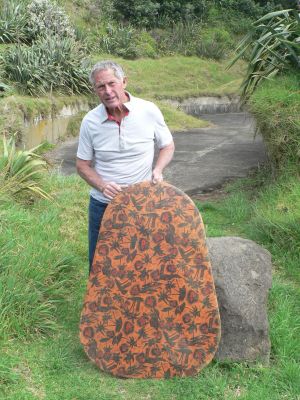
Tony and his paipo, 2011.
Photo by Bob Green. |
Tony riding on the right and Peter White at Muriwai (1967).
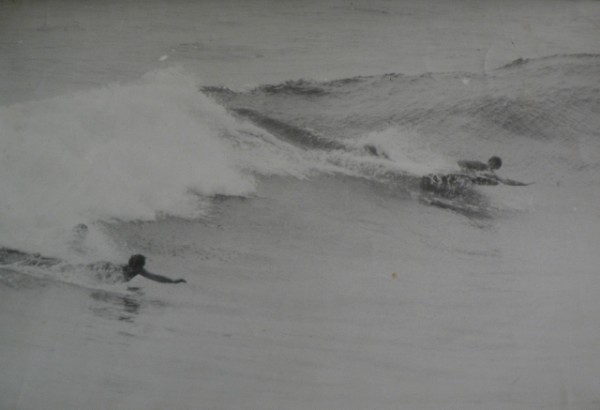
Photo courtesy of Peter White.
The photo was featured in: Flett, Neil. (1967, January 28). For speed in the surf, you can't beat a paipo. Auckland Star,
p. 38. This article appeared in the newspaper section "At you leisure."
Article and photo scan courtesy of E. Bishop, Central Auckland Research
Centre Auckland Libraries - Nga Whare Matauranga o Tamaki Makaura and
Peter White.
Could they ride hollow waves?
Oh yeah. Kept them up in the wave.
5. Who else surfed them?
Mike Lawson -- he's living on the Gold Coast -- and
my brother, Gary, used to come out [see the cameo interview with Mike Lawson below]. And a few guys around the beach waiting
to take them out for a run.
6. What is the story behind the design on the bottom?
It's Hawaiian-style cloth. With the glass you get a nice turn on them.
I've been thinking of taking the board out.
Paipo bottom
and deck views and logo.
|
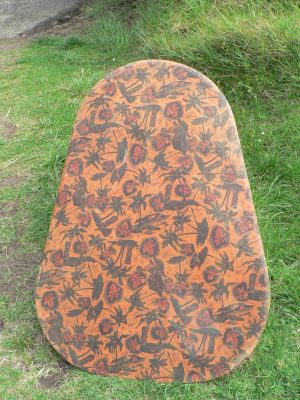
|
|
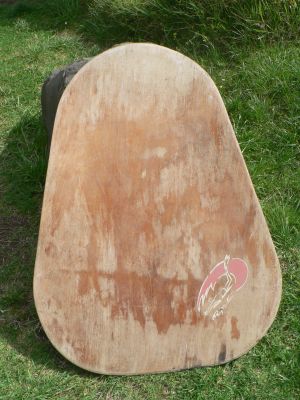
|
|
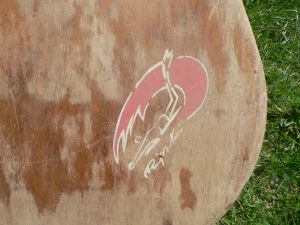
|
|
The logo says "Paipo Nui," but it is a copy of the
logo, and not the original. |
Photos by Bob Green.
|
It needs a coat of varnish.
If I took it out now it would probably suck up the moisture. It has
held it's shape.
I've heard many of the original Hawaiian paipo would
flatten out over time.
Paipo profile
|
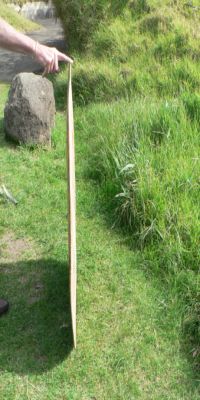
|
Photo by Bob Green. |
7. Where did you surf your board?
We used to go off Flat Rock. When the surf was
big, it was
a good way to get out. When it was big and even, you'd wait for a lull.
You'd go off the front as the swell came up. You'd jump and get sucked
out and then go like hell. It drifts north anyway so we would drift out along
and off and go out. Because the board has no buoyancy it was easy.
You must have been pretty fit to get out there?
Oh yeah. We were rowing and training hard.
8. When did you get your board?
I started my apprenticeship about 1964, so I got it a couple of years
later. I would have been 19- or 20-years-old.
So you long did you surf it for?
About 15 years.
There wouldn't be many people still surfing paipo boards then?
No, not many used them. John Skerrow has got one he's made. He's often
been onto me to borrow it and have a go. Dave Jackman is just up the road, we'll
go up and see if he's there.
Tony with Dave Jackman - November 2011
|
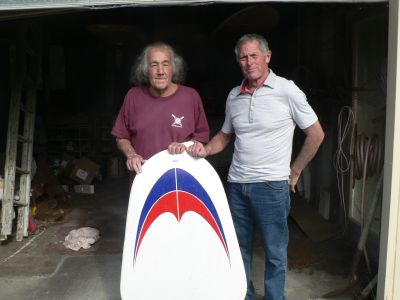
|
Photos by Bob Green. |
|
Mike Lawson
Phone
interview of January 29, 2012
There's a bit of an art to using them?
They're very good, very fast and you don't have any trouble with
surfers. They don't have a skeg on it, so if you are going down a wave
and there is a surfer in the way, you pull up the front of the board
and you just go over the top of him. They're like a skimboard, like a
skimboard on the sand. The paipo is virtually the same thing only you use
it on waves. In small surf you go left or right by tucking your arm
into the wave and that controls the speed and where you want to go. But
on big surf, 15- to 20-foot or more, you control it by leaning into the
rail and just leaning into it. You move the board around that way. By
leaning into it, you are tipping onto the edge and it works the same
way as a skeg does on a surfboard.
So how long did you ride a paipo board?
From the time Peter White brought the paipos over to the time I left the Muriwai Surf Club, when
I came to Australia. I rode it over here a few times, down at Kirra and
Rainbow Bay. I was the only person here who had one of course.
What year would that have been?
I came here in 1987. I never saw anyone riding a paipo at Rainbow Bay when I
was there. I only rode it there a couple of times. Once I left New
Zealand, I virtually gave surf life saving away, I'd did enough of it in
New Zealand. I'm too old in the tooth to do it now. I'll be a 66-year-old soon.
Tony Butt is still surfing.
He's not too far behind me. He's a natural. I could never beat Tony my
entire life. He's too good and so is Dave Jackman. Tony was a very good
athlete and so was his brother Gary.
He said his father was pretty fit guy as well.
His father was amazing, Jack Butt was an amazing man. When I did a big
rescue at Muriwai for which I got decorated by the Queen and that, it
was Jack Butt who was the guy on the rocks that helped me get the guy
out. Jack Butt is part of my life and will be in my memory forever. He
is one of my heroes. He was president of the surf club, he was still
running up the beach when he was 60. I was so sad when he went. A
lovely man.
Did you mostly surf at Muriwai or travel much?
At Muriwai. I lived at Muriwai, I had a house above Maori Bay. I
used to take it with me to surf carnivals occasionally but mainly I
used it at Muriwai.
Mike's paipo.
Bottom view and looking down - tail to nose
|
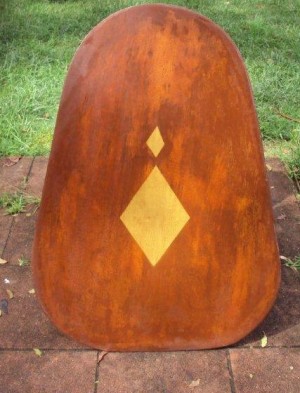
|
|

|
Photos
courtesy of Mike Lawson.
Cameo interview with Charlie Straumietis
Charlie rode a home made paipo at Muriwai. In the mid-1960s,
Charlie's dad, Jack, who was a printer, made his son a paipo. In a
series of e-mails from October 31 to December 13, 2011, Charlie wrote:
"My paipo was similar to the white one with red/blue markings - no
fins or handles. It had the names of rock bands painted on it in
varying colors (Jimi Hendrix, Cream, etc.). I was only a young
kid back then being influenced by this "new" rock 'n roll era that was
sweeping the sleepy nation of Enzed.
Surfboards were out of the question for me - too long, too heavy
and I probably wouldn't have known where to get one made any way. My
dad and I went down to the local timber yard and bought the plywood
then cut out the shape and sanded/rounded the edges (didn't know they
were called 'rails' back then). Then we steamed the thing and put lead
weights in the middle to get the curved look - basically a concave dip
to lie in when riding it. It was fatter in the tail than the white one
with red/blue markings [see photograph in Question 8 above].
Took it out to Muriwai to test it and started riding it like a boogie
board (with flippers). Then one day for no apparent reason I got to my
knees after I caught a wave and after that progressed to riding it
kneeling all the time. It was fun riding it - I simply shifted my
weight to turn the thing. After that first ride kneeling I never laid on
it again. I used the "rails" more like edge control and soon gained
enough confidence to ride it in fairly big surf.
Then one day I cut a fin out from another piece of plywood and glued it
onto the board. Surfboards had fins so I thought at the time it would
improve the paipo somehow. Took it out to Muriwai again to do the "test
pilot" thing with it. Took off on a wave and went to turn - I ended up
going straight ahead instead. Tried it a few more times but didn't like
the "new fin" so took it off and went back to riding the board without it.
When I got my driver's/bike
license I tied the thing to a rack on my
motorbike and used to ride to Raglan and surf the waves down there in
winter with no bloody wetsuit!! We didn't have them at the time. It was
a real bitch paddling the thing back out to the break after riding
waves as it hardly floated. I half swam and paddled it - bloody hard
work!! Then back on the bike for a freezing 2-hour ride back to
Auckland
staving cramps off as I huddled over the handlebars to dodge the wind.
Then along came George Greenough and his spoon. He blew the
longboarders' minds with his moves on waves and started the "short board"
era -- stuck to kneeboards ever since."
Charlie's
trail bike and spoon; Piha bar in the early-1970s.
|

|
|

|
Photos
courtesy of Charlie Straumietis.
Note 1. Riding prone has a long history in New Zealand. For example, see:
Note 2. See the paipo interview with Peter White.
|
|